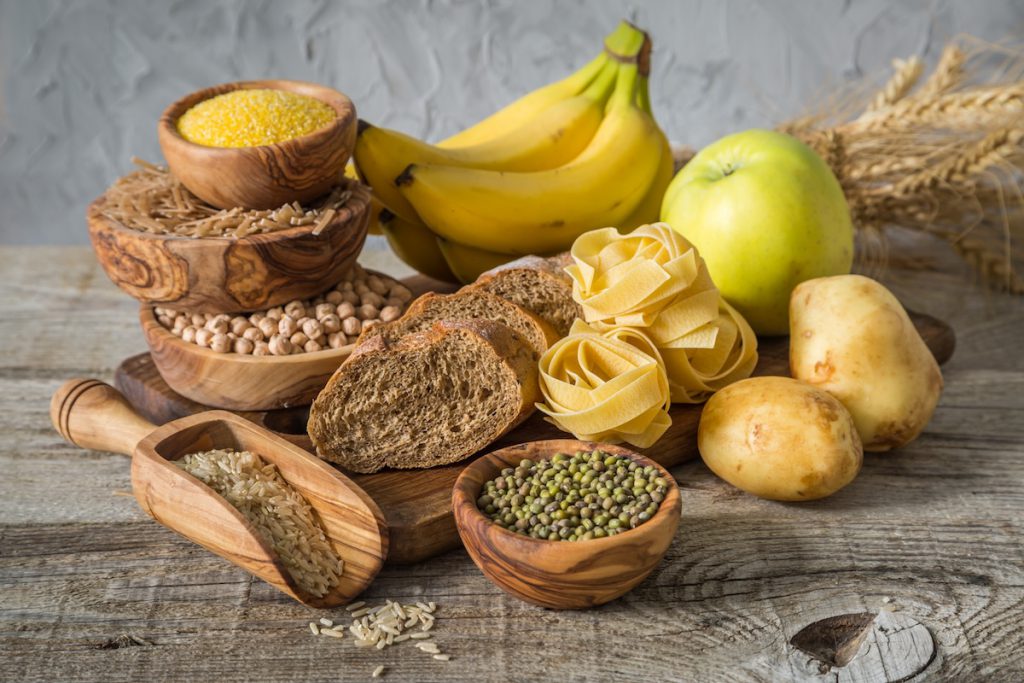4 Carb Facts You Should Know
Carbs don’t deserve their bad rap. In fact, they’re part of many healthy foods you should be eating. Here’s how to include them as part of a healthy diet.

When it comes to nutrition news, there’s often a good news–bad news tradeoff. Consider: When nutrition researchers looked at the most recent National Health and Nutrition Examination Study, which peels back the quality of the American diet, they found that many of us are eating more whole grains and less sugar. A definite positive.
However, a stubborn 42% of our average daily calories come from low-quality carbohydrates — mainly in the form of ultra-processed foods. Making better carb choices can have a big impact on your blood sugar levels, your energy drive, and your physical health from head to toe.
To help up your carb knowledge, we gathered the top facts about carbs that can make health-eating easier.
Healthy eating and fitness go together! SilverSneakers classes and events are happening right now at participating gyms, online through SilverSneakers LIVE, and at community centers near you. Activate your free online account to get started.
Carb Fact #1: You Don’t Have to Have Diabetes to Care About Carbs
Carbohydrates are the major energy source for our bodies. Your body breaks them down and turns them into glucose (blood sugar), which fuels your cells, tissues, and organs.
The reason why carbohydrate intake management is so closely connected to diabetes, is that if you eat more carbs than your body can use, the glucose sticks around, and your blood sugar level goes up. That’s a problem for people with diabetes, who are concerned about keeping a healthy blood sugar level.
But here’s the thing, having a good understanding of carbohydrate quality helps everyone make healthier food choices. That brings us to…
Carb Fact # 2: Carb Quality Is More Important Than Quantity
Not all carbs are equal. It’s good to think in terms of “low-quality” and “high-quality” carbs.
- High-quality carbs are foods that contain carbohydrate plus fiber and lots of other amounts of nutrients. They’re found in foods made from whole grains, as well as whole fruits and vegetables, beans, and legumes.
- Low-quality carbs are foods that contain carbohydrate but little fiber and not many nutrients. These include foods higher in added sugars (like sweets and sugar-sweetened beverages) and ultra-processed foods made from refined grains (like white bread, white-flour pasta and most cookies and pastries).
Research shows that eating too many low-quality carbs is associated with a higher risk of developing type 2 diabetes, heart disease, and other metabolic problems. A JAMA Internal Medicine study, for example, showed that sweetened cereals, white bread, and other low-quality carbs can cause spikes in blood sugar that may contribute to insulin resistance.
When planning well-balanced meals, try to:
- Limit low-quality carbs
- Make sure more than 50% of your grain foods are whole grain (not refined)
- Fill half you plate with vegetables
- Keep fruits and vegetables on hand for snacks
Carb Fact #3: Some Carbs Should Be Eaten Often
Plant foods are the primary source of carbs, and there are three carb types: fiber, starches, and sugars. (Most plant-based foods contain some of each.)
Fiber helps you feel full after eating and it helps keep things moving through the digestive tract. The recommended daily intake of fiber for older men is 30 grams; for women in this age group, it’s 21 grams. Check out our 10 Deliciously Simple Ways to Eat More Fiber.
Fiber tip: You can’t judge a whole grain by color alone. Today, food manufacturers are using white whole-wheat flour in more breads, pastas, and baked goods. That’s a good thing. To be sure you’re getting a whole-grain product, check the nutrition facts label and ingredients list. You can also look for the Whole Grain Stamp from the Whole Grains Council on the package, which shows the grams per serving.
Starches can be refined or whole (unrefined). Unrefined starches contain other beneficial nutrients and are found in beans, corn, peas, potatoes, brown rice and other whole grains.
White flour, white rice, and products made with these foods are considered refined starches. They contain little fiber and should play a minimal role in your diet.
Sugars also come in two categories, naturally present and added. As the name implies, naturally present sugars are found in fruits, dairy foods, and some of the sweeter vegetables (like tomatoes, squash, and beets). These foods offer a wide array of nutrients and should be enjoyed often. In fact, 50% of your daily food intake should be made up of fruits and vegetables. And low-fat and fat-free dairy foods are a good source of protein.
Added sugars, on the other hand, are foods that offer little in the way of nutrients. The name refers to the sugars found in processed foods like candy, baked goods, and some beverages. Think of these foods as a rare treat — no more than 10% of your daily sugar intake should come from added sugars.
The Nutrition Facts label is your friend. Check it to learn:
Subscribe to our newsletter
It's quick and easy. You could be one of the 13 million people who are eligible.
Already a member? Click to discover our 15,000+ participating locations.
Follow Us
- The serving size of the food
- How much total carbohydrate the food contains
- How much of that carbohydrate is from fiber or sugars (including added sugars)
Carb Fact #4: You’re Not Eating Enough Veggies (and Too Many Grains)
Chances are, you grew up eating six to 11 servings of grains per day. Updated nutrition knowledge points to vegetables and fruits being the most important food to serve at every meal.
Six servings of grains is plenty for most healthy adults, according to the American Heart Association. And at least half of those should be whole grains that are higher in dietary fiber.
In fact, grains should take up no more than one-quarter of your plate at each meal, according to the USDA’s MyPlate for Older Adults. Veggies and fruit, on the other hand, should stretch out to half your plate.
Reviewed by Jaclyn Konich, M.P.H., R.D.
See additional sources:
Understanding carbs: Diabetes.org
Dietary Guidelines for Americans, 2020-2025
MyPlate for Older Adults
Added sugars: Centers for Disease Control and Prevention
Activate Your FREE SilverSneakers Online Account
Get hundreds of free SilverSneakers On-Demand videos and stay in touch with us by creating your free online account. You don’t have to be a SilverSneakers member to get on-demand workout videos, health and fitness tips from SilverSneakers, and more.
SilverSneakers members can go to thousands of nationwide gyms and fitness locations, plus take SilverSneakers LIVE online classes led by specially trained instructors and designed for all fitness levels and abilities – at no additional cost. If you have a Medicare Advantage plan, it may include SilverSneakers. Check your eligibility here.
Already a member? Get your SilverSneakers member ID, search for locations near you, and all the health and wellness resources you need by logging in to your online member account here.




